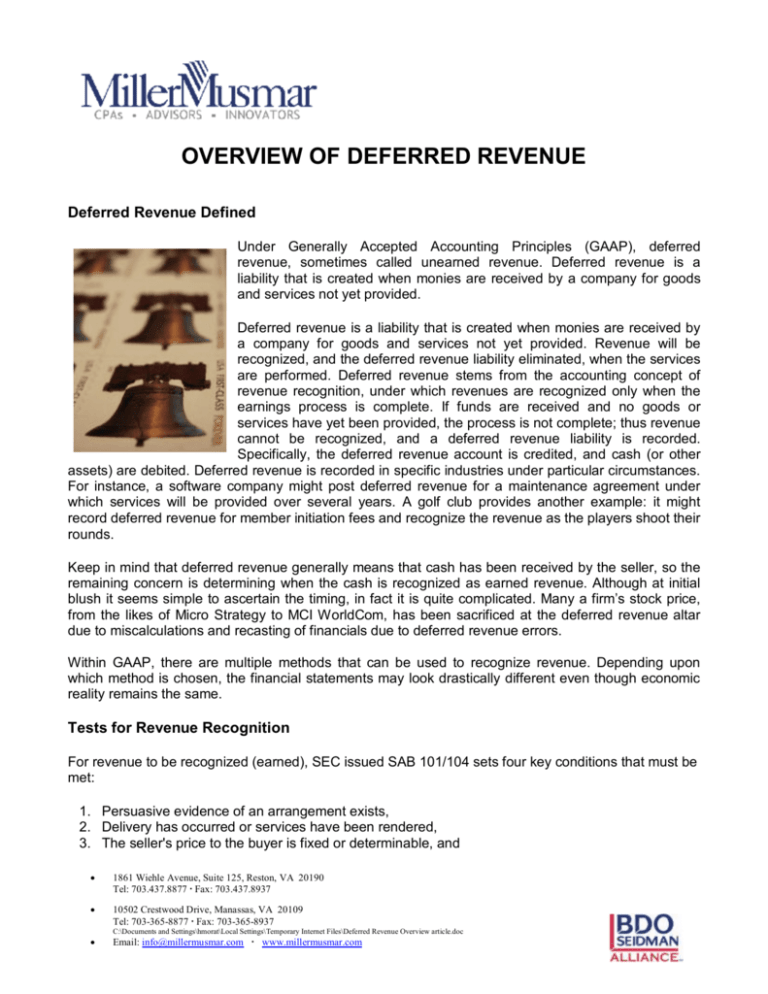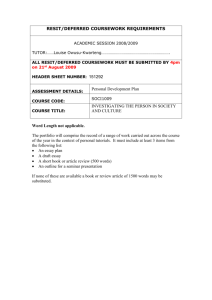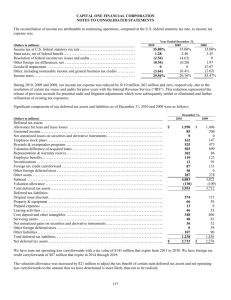Deferred Revenue Overview article
advertisement

OVERVIEW OF DEFERRED REVENUE Deferred Revenue Defined Under Generally Accepted Accounting Principles (GAAP), deferred revenue, sometimes called unearned revenue. Deferred revenue is a liability that is created when monies are received by a company for goods and services not yet provided. Deferred revenue is a liability that is created when monies are received by a company for goods and services not yet provided. Revenue will be recognized, and the deferred revenue liability eliminated, when the services are performed. Deferred revenue stems from the accounting concept of revenue recognition, under which revenues are recognized only when the earnings process is complete. If funds are received and no goods or services have yet been provided, the process is not complete; thus revenue cannot be recognized, and a deferred revenue liability is recorded. Specifically, the deferred revenue account is credited, and cash (or other assets) are debited. Deferred revenue is recorded in specific industries under particular circumstances. For instance, a software company might post deferred revenue for a maintenance agreement under which services will be provided over several years. A golf club provides another example: it might record deferred revenue for member initiation fees and recognize the revenue as the players shoot their rounds. Keep in mind that deferred revenue generally means that cash has been received by the seller, so the remaining concern is determining when the cash is recognized as earned revenue. Although at initial blush it seems simple to ascertain the timing, in fact it is quite complicated. Many a firm’s stock price, from the likes of Micro Strategy to MCI WorldCom, has been sacrificed at the deferred revenue altar due to miscalculations and recasting of financials due to deferred revenue errors. Within GAAP, there are multiple methods that can be used to recognize revenue. Depending upon which method is chosen, the financial statements may look drastically different even though economic reality remains the same. Tests for Revenue Recognition For revenue to be recognized (earned), SEC issued SAB 101/104 sets four key conditions that must be met: 1. Persuasive evidence of an arrangement exists, 2. Delivery has occurred or services have been rendered, 3. The seller's price to the buyer is fixed or determinable, and • 1861 Wiehle Avenue, Suite 125, Reston, VA 20190 Tel: 703.437.8877 Fax: 703.437.8937 • 10502 Crestwood Drive, Manassas, VA 20109 Tel: 703-365-8877 Fax: 703-365-8937 • C:\Documents and Settings\hmorat\Local Settings\Temporary Internet Files\Deferred Revenue Overview article.doc Email: info@millermusmar.com www.millermusmar.com 4. Collectability is reasonably assured According to SFAC Recognition and Measurement in Financial Statements of Business Enterprises for revenue to be recognized, there are two key conditions that must be met: 1. Completion of the Earnings Process The seller must have no significant remaining obligation to the customer. If an order is partially completed, the transaction is deemed not complete. Likewise, if the seller also provides a guarantee, the portion of the sale that represents the guarantee is not earned. Normally the cost of providing the guarantee needs to be included so that the entire transaction is recognized as revenue. This is why warranties and guarantees are normally provided by third parties otherwise the company cannot recognize earned revenue unless the cost of providing that service can be reasonably estimated. 2. Assurance of Payment This point is self explanatory; the company needs to believe that it will be paid in full. Revenue Recognitions Methods Each industry has some standard method of recognizing revenue and addressing deferred revenue. The most popular methods are: I. Sales Basis This is the method that probably makes the most sense to investors. Under the sales basis method, revenue is recognized at the time of sale (defined as the moment when the title of the goods or services is transferred to the buyer.) The sale can be for cash or credit (i.e., accounts receivable.) This means that revenue is not recognized even if cash is received before the transaction is complete. A car magazine publisher, that receives $240 a year for an annual subscription, will recognize $10 of earned revenue per month. The revenue only gets recognized by the publisher when the services, in this example, the magazine is delivered and, therefore, earned. II. Cost Recoverability Method The cost recoverability approach is used when a company cannot reasonably estimate the total expense required to complete a project. The result is that no profit is recognized at all until all of the expenses incurred to complete the project have been recouped. This is the most conservative revenue recognition method of all. It is important to note that it is not accepted by certain authorities. A good example is the development of internal software. Assume that an IT firm developed its own software at a total cost of ten million dollars. Then, some years later, the firm • 1861 Wiehle Avenue, Suite 125, Reston, VA 20190 Tel: 703.437.8877 Fax: 703.437.8937 • 10502 Crestwood Drive, Manassas, VA 20109 Tel: 703-365-8877 Fax: 703-365-8937 • C:\Documents and Settings\hmorat\Local Settings\Temporary Internet Files\Deferred Revenue Overview article.doc Email: info@millermusmar.com www.millermusmar.com decides to sell the software to customers. Under the cost recoverability method of revenue recognition, all revenue earned would first serve as an offset to the original $10 million in development expense. Nothing would appear in the income statement as revenue until the entire original balance of $10 million had been used up. III. Percentage of Completion Companies that build buildings take more than a year to complete their project. Therefore, the builder wants to show its shareholders that it is generating revenue and profits even though the project itself is not yet complete. The percentage of completion method for revenue recognition is an acceptable method and qualifies as viable method if two conditions are met: 1. There is a long-term legally enforceable contract and 2. It is possible to estimate the percentage of the project complete, revenues and costs. IV. Installment Sale When the actual collection of cash is in question, a company should use the installment method of revenue recognition. This is primarily used in real estate transactions in which the sale may be agreed upon but the cash collection is subject to the risk of the buyer's financing not working out. Therefore, gross profit is only calculated in proportion to cash received. For example, assume a developer spent $1,000,000 building a commercial building. The developer sold the property for $7,500,000 but the buyer is going to pay in three equal installments one payment per year. On the first and second due dates, the developer receives a check for two thirds of what is owed. The developer’s income statement is now going to reflect sixty six percent of the revenue and gross profit earned since he has collected sixty six percent of the cash. V. Estimating Models Normally, these models are custom designed for companies that cannot ascertain timing of service performance and therefore, rely on some kind of model that can calculate a percentage of (probably of) performance of the service/delivery of product so that revenue can be deemed earned and booked in the income statement. These models are normally fairly straight forward (random) while others can be complex (e.g. cluster, probability, etc.) and require regular fine tuning so that they can properly guide customer behavior and proper breakage percentages. The complicated models are normally relegated to publically traded entities and entities with unique product/service characteristics. • 1861 Wiehle Avenue, Suite 125, Reston, VA 20190 Tel: 703.437.8877 Fax: 703.437.8937 • 10502 Crestwood Drive, Manassas, VA 20109 Tel: 703-365-8877 Fax: 703-365-8937 • C:\Documents and Settings\hmorat\Local Settings\Temporary Internet Files\Deferred Revenue Overview article.doc Email: info@millermusmar.com www.millermusmar.com The Bottom Line As you might already be able to conclude, a person in charge of a firm's financials can, by changing a revenue recognition model, dramatically alter the income statement by over/understating revenue and therefore, altering profit timing. For example, a contract accounted for using the percentage-ofcompletion method for revenue recognition instead of the completed contract method will result in higher assets, higher equity, lower liabilities, and, therefore, a lower debt-to-equity ratio. On the flip side, a business that uses the completed contract method is going to report no income in the first years of the contract, meaning no taxes will be paid. Also, the shareholders of this business are going to be told that they are earning less but their wealth is going to be greater because there is capital being used in the business, tax-deferred. Also, many companies use deferred revenue to show smoother earnings over a several year period despite the fact that the economic health of the business would be exactly the same. The issue remains that official guidance is not specific enough to address how deferred revenue models need to be established and regulated. Each entity is left on its own to fend for itself in how it calculates deferred revenue. For more information on how to calculate deferred revenue for your firm or have your existing deferred revenue calculated please contact us at info@millermusmar.com or call our main office in Reston, Virginia at 703-437-8877. Please be advised that, based on current IRS rules and standards, the advice contained herein is not intended or written by the practitioner to be used and cannot be used by the taxpayer for the purpose of avoiding penalties. • 1861 Wiehle Avenue, Suite 125, Reston, VA 20190 Tel: 703.437.8877 Fax: 703.437.8937 • 10502 Crestwood Drive, Manassas, VA 20109 Tel: 703-365-8877 Fax: 703-365-8937 • C:\Documents and Settings\hmorat\Local Settings\Temporary Internet Files\Deferred Revenue Overview article.doc Email: info@millermusmar.com www.millermusmar.com



